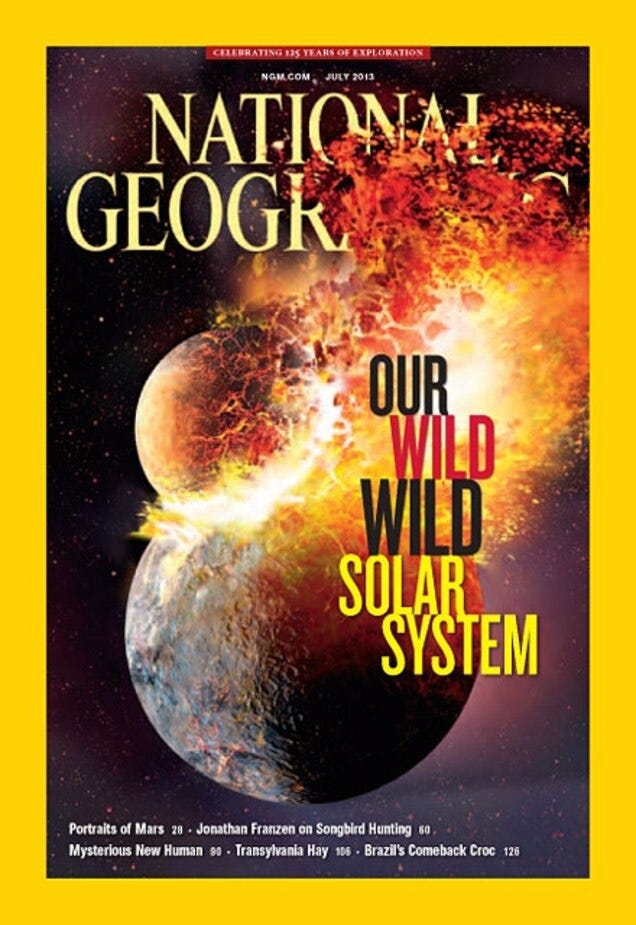Endangered Watch
The painful end to National Geographic magazine and the struggling of print media
My first English magazine was a copy of National Geographic, specifically the July 2013 issue. Admittedly, as a space nerd and as a kid, the reason I bought it is because the cover is titled “Our Wild Wild Solar System” and features an artwork of a smaller planet smashing into a bigger planet.
I haven’t been the most loyal reader after that, but ever since 2017 I have never missed an issue and decided to subscribe to the magazine. Just a few days ago I received the July 2023 issue, exactly ten years since the first issue I bought of National Geographic. Which is why it pains me to see this reporting from the Washington Post:
National Geographic lays off its last remaining staff writers
The magazine, which remains among the most read in the U.S., has struggled in the digital era to command the kind of resources that fueled the deep reporting it became known for
On Wednesday, the Washington-based magazine that has surveyed science and the natural world for 135 years reached another difficult passage when it laid off all of its last remaining staff writers.
The cutback — the latest in a series under owner Walt Disney Co. — involves some 19 editorial staffers in all, who were notified in April that these terminations were coming. Article assignments will henceforth be contracted out to freelancers or pieced together by editors. The cuts also eliminated the magazine’s small audio department.
…
Departing staffers said Wednesday the magazine has curtailed photo contracts that enabled photographers to spend months in the field producing the publication’s iconic images.
To make things even worse, The AP reported:
The familiar yellow-bordered cover of the monthly National Geographic will no longer be for sale on newsstands starting next year, part of cutbacks affecting the venerable magazine.
The company’s focus is turning to its digital product and it will offer special editions on newsstands, a spokesman said on Thursday. Subscribers will still get a printed copy each month.
It is a sad moment to see this happen to a renowned magazine, but unfortunately newsroom sackings and media layoffs are becoming more frequent in recent months. That is in addition to the shutdowns of media organisations like Buzzfeed News and bankruptcies happening to news websites like Vice. Even the longest running national newspaper printed its final edition this weekend.
For print media, even the more reputable papers and magazines have struggled to find relevance in a deeply digital world. I will get into how struggling other magazines like Time are not coping well with a shifting media landscape, but for this article a brief analysis on National Geographic.
Over the recent years, flicking through the magazine issues, I do see a decline in quality and content rooted in the magazine editorial staff not knowing which way to go, something that is not completely their fault.
The success National Geographic stems from is investigative journalism and brilliant photography, works that take time and effort to make it work. However, in a media environment filled with clickbait and flashy headlines, print media like National Geographic struggle to hang on.
And that shows in their magazine issues, for example since 2021 the magazine has kept producing pictures of the year type of issues to fill in an entire magazine issue. As a personal speculation, I am guessing the editorial board decided to make one issue solely based on photos given they don’t have any new articles on stock, as well as they have too many photographs they love but are unable to show them in a different manner in the magazine. In another perspective, they are trying to imitate Time with its plethora of annual awards from Person Of The Year to the Time 100 list.
Also, there are issues with the cover story, or the entire issue, being used as essentially a big advertisement disguised as a brand new article piece or a complete new issue. The magazine has promoted its Disney + documentaries Limitless with Chris Hemsworth and Welcome To Earth with unrelenting coverage and page numbers trying to engage any readers to tune onto their streaming service and start watching the show.
Regardless, it is a sad note to see the magazine after 130 years having to go through such a momentous change, happening in a harsh and painful way. Hopefully it marks a positive new beginning for the magazine, but the test of time and innovation might say otherwise.







